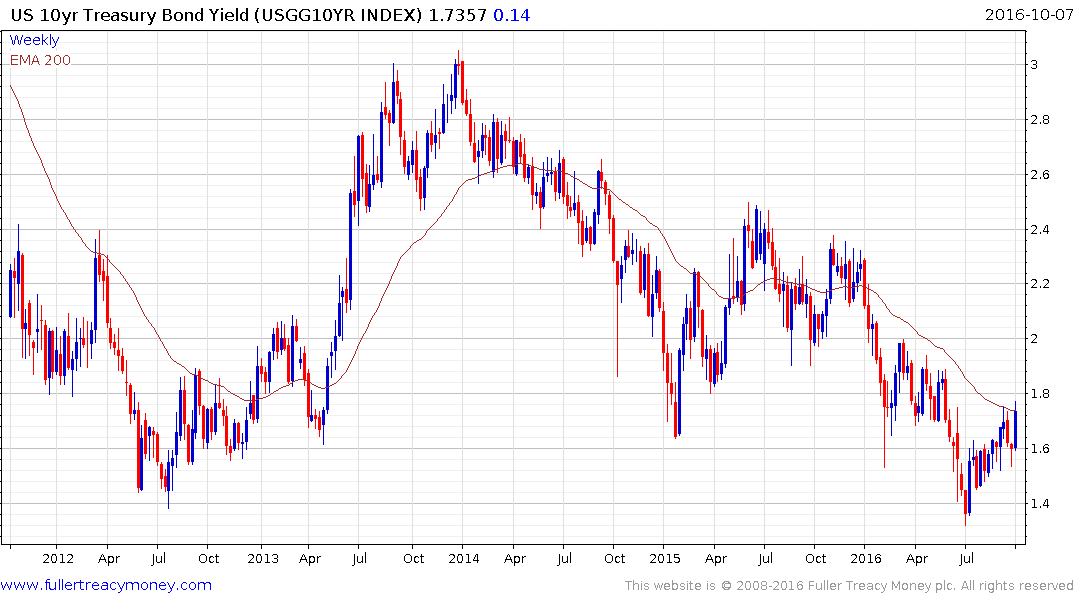Remarks at the 40th Annual Central Banking Seminar
This transcript of a speech by Ray Dalio of Bridgewater Capital to the New York Fed may be of interest to subscribers. Here is a section:
As a result of this confluence of conditions, we are now seeing most central bankers pushing interest rates down to make them extremely unattractive for savers and we are seeing them monetizing debt and buying riskier assets to make debt and other liabilities less burdensome and to stimulate their economies. Rarely do we investors get a market that we know is over-valued and that approaches such clearly defined limits as the bond market now. That is because there is a limit as to how negative bond yields can go. Their expected returns relative to their risks are especially bad. If interest rates rise just a little bit more than is discounted in the curve it will have a big negative effect on bonds and all asset prices, as they are all very sensitive to the discount rate used to calculate the present value of their future cash flows. That is because with interest rates having declined, the effective durations of all assets have lengthened, so they are more price-sensitive. For example, it would only take a 100 basis point rise in Treasury bond yields to trigger the worst price decline in bonds since the 1981 bond market crash. And since those interest rates are embedded in the pricing of all investment assets, that would send them all much lower.
At the same time, as bonds become a very bad deal and central banks try to push more money into the market and yields go even lower and price risks increase further, savers might decide to go elsewhere. At existing rates of central bank buying—which I believe will be required for the foreseeable future—central banks are going to start to hit the limits of their existing constraints. Those limits were put into place because they originally thought that they were prudent but they are going to have to go buy other things. Right now, a number of the riskier assets look attractive in relationship to bonds and cash, but not cheap in relationship to their risks. If this continues, holding non-financial storeholds of wealth like gold could become more attractive than holding long duration fiat currency flows with negative yields (which is what bonds are), especially if currency volatility picks up.
Concerning what policies will likely be required of central bankers given the reduced effectiveness of interest rate cuts and quantitative easing, and assuming that political limitations on fiscal policies and structural reforms remain stringent, it appears to me that there will have to be greater purchases of riskier assets and more direct placements of purchasing power in the hands of spenders, especially as the previously described squeeze intensifies.
The number of large bond investors calling for direct provision of liquidity to consumers is growing steadily as serious doubts about the sustainability of negative yields continue to be voiced. In central bank parlance that equates to helicopter money.
The contradiction of negative yields, which are totally reliant on momentum to compensate the investor for paying rather than receiving a yield, has been created by central banks. The big question is at what point central banks, particularly the BoJ and ECB, are going to admit they are encouraging deflation rather than combatting it.
If the massive unfunded liabilities outstanding across much of the G7 are ever going to be met then a mix of inflation, higher retirement ages, higher taxes and lower pay-outs is going to have to be negotiated and that is unlikely to be a trouble free process politically.
While the US government bond market is not the focus of the negative interest rates issue, the potential for interest rates to rise represents a change to the global status quo and has potentially contributed to the uptick in volatility seen recently.

German and Japanese 10-year bond yields are trading in the region of the zero bound but US Treasury yields have surged this week to retest the region of the trend mean. Some consolidation is looking increasingly likely but a sustained move above it will be required to signal more than near-term supply dominance.


